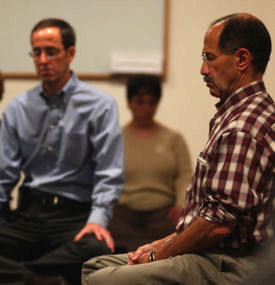Staffing can make or break a small practice
In a quest to unveil common problems for small practices and offer solutions, the College's Center for Practice Innovation visited 34 practices across the U.S. over a two-year period. Part one of the six-part series looks at the unique staffing issues faced by small offices.
Barbara Magera, ACP Member, learned a few lessons about her practice in the most difficult of ways: through the death of a beloved employee.
Derek Richardson was a jack-of-all-trades in the Charleston, S.C. practice that Dr. Magera, an allergist, shares with her gastroenterologist husband. Bright and diplomatic, Mr. Richardson handled many employee issues: explaining payroll, vacation policy and computer etiquette to those who needed reminding, getting new staff up to speed. He negotiated with insurance companies and organized the unit dosing system. And he was a whiz at computers.

When Mr. Richardson died in a car accident in September 2006, after nearly six years at the practice, it was a blow both personal and professional. In addition to her grief, Dr. Magera had serious practical issues to deal with. “I spent the better part of a year in catch-up,” she said.
While Dr. Magera's practice is an extreme example, staff shake-ups were common among the small practices visited by the College's Center for Practice Innovation (CPI) during its two-year quality improvement project. (see sidebar.) One solo practice lost an office manager when she gave birth. Five practices saw more than 50% of their staff leave. Several others gained or lost clinicians.
“Staffing was a much bigger issue than we expected,” said Will Underwood, senior associate with the CPI. “And staff can make or break your practice.”
Indeed, employees play a large role in whether a practice is able to successfully implement quality changes, like the use of electronic medical records or an updated scheduling system. Although certain staff challenges are unavoidable, their impact can be dampened through preventive steps. Other staff problems can be averted entirely.
An unexpected departure
When Mr. Richardson died, he took with him many of the passwords and codes that kept Dr. Magera's practice humming.
“All our hospital credentialing documents and continuing education certificates were in cyberspace, and we didn't know how to get to it,” Dr. Magera said. “We had to do it all over again by hand.”
The experience led Dr. Magera to realize that she needed a method of sharing information with several employees, particularly with those who work with critical documents. That meant making sure passwords were written down and stored in a safe place, as well as learning how various computer programs worked.
“You need to be captain of the ship,” Dr. Magera said. “Doctors have to get involved in understanding things like documents saved in cyberspace, as well as insurance contracts and reimbursements.”
Yet physicians shouldn't confuse knowing their practice's mechanics with doing all the work. Financially speaking, it's best to leave administrative tasks to the staff, and for doctors to do what they are trained for, said Deborah Walker Keegan, PhD, president of consulting firm Medical Practice Dimensions, Inc, during the annual Medical Group Management Association (MGMA) conference in October.
“I just love seeing that $200-an-hour physician escorting a charge ticket around the practice, or bypassing the check-in practice to retrieve her own patients,” Dr. Keegan said. “That's a poor use of physician time.”
The same philosophy holds true for other staff, said Michael Barr, FACP, CPI director.
“If you bring on a medical assistant but just limit that person to filing, doing chart pulls and vitals, he or she isn't using his or her full capability,” Dr. Barr said. “Employees should practice to the full extent of their licenses and training. Doing so not only improves productivity of the office, it usually enhances morale and satisfaction.”
Cross-training staff in front and back office duties is another good way to hedge against the sudden loss of an employee, Dr. Barr said. It also helps on days when an employee is sick, or the practice is overburdened in a certain area, like with referrals or scheduling, and needs more hands on deck.
“While staff should do what they are trained for most of the time, it's a good idea to enhance everyone's skill sets,” Dr. Barr said. “It also offers employees the chance to learn new things.”
Resistance to change
Not everyone welcomes a change in job function or the opportunity to learn, however.
Just ask Faith Protsman, ACP Member candidate and solo general internist in Gilroy, CA.
Trouble began to surface at Dr. Protsman's practice when she implemented an e-prescribing system. A back office employee was standing at the machine for long stretches of time, stacks of paper at her side, yet she managed to process only four or five refill requests per hour. Dr. Protsman found out later that she was spending much of her work time on personal emails and instant messaging.
Meanwhile, the doctor's attempt to streamline documentation in the front office wasn't going well, either. Receivables weren't coming in, and the staff neglected to do tasks that Dr. Protsman requested, saying they were overworked. In fact, said the doctor, the new computerized system meant they didn't have enough to do.
“In retrospect, I think the front office people recognized their work no longer required two people, that one person working hard could take care of it,” Dr. Protsman said. “But they didn't want me to figure it out, because they were worried about losing their jobs.”
The staff was also resistant to implementing technological change in the office. One employee was so stressed about the prospect of electronic medical records (EMRs) that she took a leave of absence.
“When she left, I realized how little she had done during her many hours of work,” Dr. Protsman said. “We had over $30,000 in uncollected accounts receivable that were more than six months old.”
The final straw came when Dr. Protsman had to leave the office for two months for unexpected surgery. When she returned, she found her staff had not done the work she'd asked, which was to populate new forms to help the office transition to EMR. Seeing the writing on the wall, the employees resigned.
One lesson from Dr. Protsman's ordeal is that it's important for physicians or their office managers to know how much time certain tasks should take, and to keep an eye on whether staff is performing to that standard, Mr. Underwood said.
A full-time employee should be able to schedule 50-75 patients per day with full registration, or 75-125 with no registration, Dr. Keegan said. A triage nurse should be able to see 65-75 patients, while a referral specialist should be able to process 70-90 referrals, in a seven-hour day, she said.
If a physician finds a staffer isn't performing up to snuff, he or she needs to take the time and energy to talk to the employee. Admittedly, this can be tough in small practices, when employees are often family members or have been with the practice for years, Dr. Barr said.
“When you are talking about small practices, you are talking about small businesses: 40% of the CPI practices were family-run. In one extreme case during our project, a physician and his son-in-law were the providers, his wife ran the office and his daughter ran the lab,” Dr. Barr said. “The trick for a physician is to provide guidance without jeopardizing personal relationships.”
Dr. Protsman now has two full-time staff who are cross-trained in front and back office duties. They get more done in less time than the four old employees, and the workflow is much smoother, she said.
“My employees are not only up to speed on the new system, they are willing to learn and grow with the practice,” Dr. Protsman said. “I'm seeing more patients and providing more complete care, and I'm getting out of there (earlier).”
Stiff competition
Last year, Asha Nath, FACP, a general internist in Indio, CA, ran through six employees in three months at the practice she shares with her gastroenterologist husband. The reason? Competition.
Huge casinos in the area have always paid better than a small practice can- but a practice can attract people who prefer an office environment, Dr. Nath said. When Kaiser Permanente opened a few clinics nearby, however, they hired medical staff for higher pay and better benefits than Dr. Nath offered, she said.
The physician decided to make some changes in an effort to make her workplace more enticing. Instead of setting aside an allowance for employees that they were meant to apply to health care costs, she set up a group insurance plan. She also raised salaries.
It worked: Dr. Nath has had the same four employees for 10 months and counting, which has saved her time and money on recruiting and retraining. Though there is still an added expense to her practice from the changes, it is worth it, she said.
“My income decreased somewhat, but my husband and I are not suffering. With a steady staff, we have more peace of mind, and this point in my life, that is more important than $10,000 in the pocket,” Dr. Nath said.
Small practices need to analyze their competitors and see what they can offer that might be different and more enticing, Dr. Barr said. It's not just money or benefits that might encourage an employee to sign on, or to stay, he added.
“Lifestyle, satisfaction, camaraderie, a sense of mission and belonging all impact employee retention,” Dr. Barr said. “Money is important, but it isn't everything.”
Using staff smartly
In an attempt to provide attentive service to patients, Dr. Nath's practice inadvertently did the opposite. Employees would take turns greeting patients, then escorting them through the entire system to check-out. That often left new patients waiting around and feeling neglected during busy times. It also made it difficult to track who was doing what, Mr. Underwood said.
The CPI advised Dr. Nath to give employees defined tasks: one employee to check patients in, another to check them out, for example.
“Rather than having everyone try to do everything, we advised having specific people do specific things,” Mr. Underwood said. “Staff could rotate tasks during the week to avoid getting burned out, but on any given day, you'd have an assigned person doing dedicated tasks.”
After Dr. Nath clarified her staff's duties, her patient feedback forms became more positive, Mr. Underwood noted.
“The staff is who your patient has first and last contact with, so the patient's whole image of your practice will be tainted one way or the other by that experience,” Mr. Underwood said.
Quick huddles each morning are another good way to keep employees abreast of what's going on with the practice, which in turn will help with workflow, Mr. Underwood advised. “On numerous occasions in different practices, we discovered that the doctors thought things were happening one way and the front desk thought something else,” he said. “A huddle lets staff touch base about the details.”
Good staff utilization is often a process of trial and error, he added. But it can make all the difference to the success of a practice.
“Having a stable, usable staff enables you to do things with quality and your work flow that you can't without that support,” Mr. Underwood said. “It also affects your quality of life and patient care.”
Next month in the CPI Series: The challenges and rewards of implementing electronic health records.
Staffing Tips:
Follow these steps to avoid staffing problems:
- Cross-train front and back office staff on important duties.
- Create an employee handbook that spells out things like computer use and pay rules.
- Know how long it should take your staff to do their jobs, and monitor productivity.
- Make sure your staff are busy, but not overworked.
- Resist the urge to do staff jobs yourself.
- Touch base with staff through quick daily huddles and weekly meetings.
- Be willing to make big changes, like replacing staff or raising salaries, when necessary.
- Have a correct staffing ratio. The College's Practice Management Center recommends 3.3 full-time support staff for each full-time provider (including mid-level providers).
- Consult staff before making changes to workflow, to ensure the changes makes sense for them.
About this series
In a quest to unveil common problems for small practices and offer solutions, the College's Center for Practice Innovation (CPI) visited 34 practices across the U.S. over a two-year period. Members of the center's three-person team assessed each practice on a variety of factors, such as scheduling, work flow, documentation and safety. They offered individual recommendations and resources for improvement, then returned to the practices a year later to see how they did.
Through a series of six articles, ACP Internist will explore the issues the CPI encountered during its visits, the advice the center gave, and how the practices responded. This month's article looks at challenges related to staffing, while upcoming issues will discuss implementation of electronic health records and inbound logistics such as scheduling and phone systems.
Here is a snapshot of the 34 practices chosen for the CPI program:
- Practices on the Eastern Seaboard: 18
- Practices in the Western U.S. and Texas: 10
- Practices in the Midwest: 6
- Average number of physicians per practice: 1.55
- Average number of clinicians (including PAs and NPs): 2.0
- Average number of examination rooms: 4.5
- Average number of patients: 3,175
- Clinical staff to clinician ratio: 1.16
- Administrative staff to clinician ratio: 1.14




